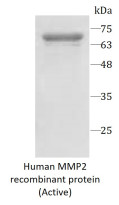ARG70450
Human MMP2 recombinant protein (His-tagged, C-ter)
Human MMP2 recombinant protein (His-tagged, C-ter) for SDS-PAGE
Overview
| Product Description | E. coli expressed, His-tagged (C-ter) Human MMP2 recombinant protein |
|---|---|
| Tested Application | SDS-PAGE |
| Target Name | MMP2 |
| Species | Human |
| A.A. Sequence | Tyr120 - Cys660 |
| Expression System | E. coli |
| Protein Full Name | 72 kDa type IV collagenase |
| Alternate Names | MMP2; Matrix Metallopeptidase 2; TBE-1; CLG4A; 72 KDa Type IV Collagenase; Matrix Metalloproteinase-2; EC 3.4.24.24; MMP-2; CLG4; Matrix Metalloproteinase 2 (Gelatinase A, 72kDa Gelatinase, 72kDa Type IV Collagenase) |
Properties
| Form | Powder |
|---|---|
| Purification Note | Endotoxin level is less than 0.1 EU/µg of the protein, as determined by the LAL test. |
| Purity | > 95% (by SDS-PAGE) |
| Buffer | PBS (pH 8.0) |
| Reconstitution | It is recommended to reconstitute the lyophilized protein in sterile water to a concentration not less than 200 μg/mL and incubate the stock solution for at least 20 min at room temperature to make sure the protein is dissolved completely. |
| Storage Instruction | For long term, lyophilized protein should be stored at -20°C or -80°C. After reconstitution, aliquot and store at -20°C or -80°C for up to one month. Storage in frost free freezers is not recommended. Avoid repeated freeze/thaw cycles. Suggest spin the vial prior to opening. |
| Note | For laboratory research only, not for drug, diagnostic or other use. |
Bioinformation
| Gene Symbol | MMP2 |
|---|---|
| Gene Full Name | Matrix Metallopeptidase 2 |
| Background | This gene is a member of the matrix metalloproteinase (MMP) gene family, that are zinc-dependent enzymes capable of cleaving components of the extracellular matrix and molecules involved in signal transduction. The protein encoded by this gene is a gelatinase A, type IV collagenase, that contains three fibronectin type II repeats in its catalytic site that allow binding of denatured type IV and V collagen and elastin. Unlike most MMP family members, activation of this protein can occur on the cell membrane. This enzyme can be activated extracellularly by proteases, or, intracellulary by its S-glutathiolation with no requirement for proteolytical removal of the pro-domain. This protein is thought to be involved in multiple pathways including roles in the nervous system, endometrial menstrual breakdown, regulation of vascularization, and metastasis. Mutations in this gene have been associated with Winchester syndrome and Nodulosis-Arthropathy-Osteolysis (NAO) syndrome. Alternative splicing results in multiple transcript variants encoding different isoforms. |
| Function | Ubiquitinous metalloproteinase that is involved in diverse functions such as remodeling of the vasculature, angiogenesis, tissue repair, tumor invasion, inflammation, and atherosclerotic plaque rupture. As well as degrading extracellular matrix proteins, can also act on several nonmatrix proteins such as big endothelial 1 and beta-type CGRP promoting vasoconstriction. Also cleaves KISS at a Gly-|-Leu bond. Appears to have a role in myocardial cell death pathways. Contributes to myocardial oxidative stress by regulating the activity of GSK3beta. Cleaves GSK3beta in vitro. Involved in the formation of the fibrovascular tissues in association with MMP14. |
| Cellular Localization | Cytoplasm, Extracellular matrix, Membrane, Mitochondrion, Nucleus, Secreted |
| PTM | Autocatalytic cleavage, Disulfide bond, Glycoprotein, Phosphoprotein, Zymogen |
Images (1) Click the Picture to Zoom In






